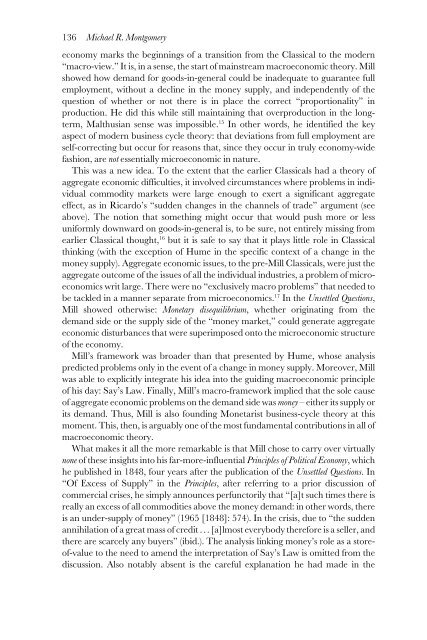Money and Markets: Essays in Honor of Leland B. Yeager
Money and Markets: Essays in Honor of Leland B. Yeager
Money and Markets: Essays in Honor of Leland B. Yeager
Create successful ePaper yourself
Turn your PDF publications into a flip-book with our unique Google optimized e-Paper software.
136 Michael R. Montgomeryeconomy marks the beg<strong>in</strong>n<strong>in</strong>gs <strong>of</strong> a transition from the Classical to the modern“macro-view.” It is, <strong>in</strong> a sense, the start <strong>of</strong> ma<strong>in</strong>stream macroeconomic theory. Millshowed how dem<strong>and</strong> for goods-<strong>in</strong>-general could be <strong>in</strong>adequate to guarantee fullemployment, without a decl<strong>in</strong>e <strong>in</strong> the money supply, <strong>and</strong> <strong>in</strong>dependently <strong>of</strong> thequestion <strong>of</strong> whether or not there is <strong>in</strong> place the correct “proportionality” <strong>in</strong>production. He did this while still ma<strong>in</strong>ta<strong>in</strong><strong>in</strong>g that overproduction <strong>in</strong> the longterm,Malthusian sense was impossible. 15 In other words, he identified the keyaspect <strong>of</strong> modern bus<strong>in</strong>ess cycle theory: that deviations from full employment areself-correct<strong>in</strong>g but occur for reasons that, s<strong>in</strong>ce they occur <strong>in</strong> truly economy-widefashion, are not essentially microeconomic <strong>in</strong> nature.This was a new idea. To the extent that the earlier Classicals had a theory <strong>of</strong>aggregate economic difficulties, it <strong>in</strong>volved circumstances where problems <strong>in</strong> <strong>in</strong>dividualcommodity markets were large enough to exert a significant aggregateeffect, as <strong>in</strong> Ricardo’s “sudden changes <strong>in</strong> the channels <strong>of</strong> trade” argument (seeabove). The notion that someth<strong>in</strong>g might occur that would push more or lessuniformly downward on goods-<strong>in</strong>-general is, to be sure, not entirely miss<strong>in</strong>g fromearlier Classical thought, 16 but it is safe to say that it plays little role <strong>in</strong> Classicalth<strong>in</strong>k<strong>in</strong>g (with the exception <strong>of</strong> Hume <strong>in</strong> the specific context <strong>of</strong> a change <strong>in</strong> themoney supply). Aggregate economic issues, to the pre-Mill Classicals, were just theaggregate outcome <strong>of</strong> the issues <strong>of</strong> all the <strong>in</strong>dividual <strong>in</strong>dustries, a problem <strong>of</strong> microeconomicswrit large. There were no “exclusively macro problems” that needed tobe tackled <strong>in</strong> a manner separate from microeconomics. 17 In the Unsettled Questions,Mill showed otherwise: Monetary disequilibrium, whether orig<strong>in</strong>at<strong>in</strong>g from thedem<strong>and</strong> side or the supply side <strong>of</strong> the “money market,” could generate aggregateeconomic disturbances that were superimposed onto the microeconomic structure<strong>of</strong> the economy.Mill’s framework was broader than that presented by Hume, whose analysispredicted problems only <strong>in</strong> the event <strong>of</strong> a change <strong>in</strong> money supply. Moreover, Millwas able to explicitly <strong>in</strong>tegrate his idea <strong>in</strong>to the guid<strong>in</strong>g macroeconomic pr<strong>in</strong>ciple<strong>of</strong> his day: Say’s Law. F<strong>in</strong>ally, Mill’s macro-framework implied that the sole cause<strong>of</strong> aggregate economic problems on the dem<strong>and</strong> side was money – either its supply orits dem<strong>and</strong>. Thus, Mill is also found<strong>in</strong>g Monetarist bus<strong>in</strong>ess-cycle theory at thismoment. This, then, is arguably one <strong>of</strong> the most fundamental contributions <strong>in</strong> all <strong>of</strong>macroeconomic theory.What makes it all the more remarkable is that Mill chose to carry over virtuallynone <strong>of</strong> these <strong>in</strong>sights <strong>in</strong>to his far-more-<strong>in</strong>fluential Pr<strong>in</strong>ciples <strong>of</strong> Political Economy, whichhe published <strong>in</strong> 1848, four years after the publication <strong>of</strong> the Unsettled Questions. In“Of Excess <strong>of</strong> Supply” <strong>in</strong> the Pr<strong>in</strong>ciples, after referr<strong>in</strong>g to a prior discussion <strong>of</strong>commercial crises, he simply announces perfunctorily that “[a]t such times there isreally an excess <strong>of</strong> all commodities above the money dem<strong>and</strong>: <strong>in</strong> other words, thereis an under-supply <strong>of</strong> money” (1965 [1848]: 574). In the crisis, due to “the suddenannihilation <strong>of</strong> a great mass <strong>of</strong> credit . . . [a]lmost everybody therefore is a seller, <strong>and</strong>there are scarcely any buyers” (ibid.). The analysis l<strong>in</strong>k<strong>in</strong>g money’s role as a store<strong>of</strong>-valueto the need to amend the <strong>in</strong>terpretation <strong>of</strong> Say’s Law is omitted from thediscussion. Also notably absent is the careful explanation he had made <strong>in</strong> the
















